|
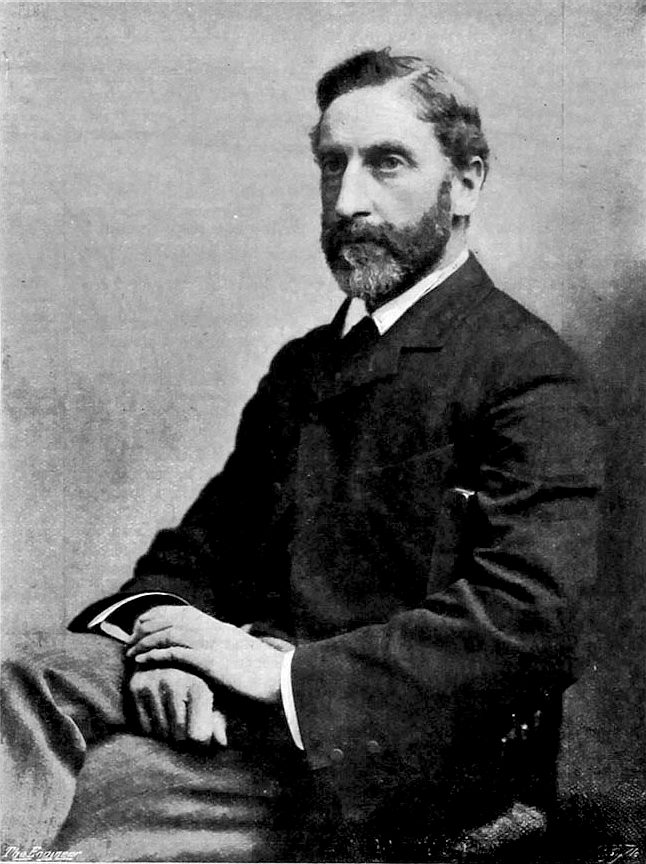
DR. JOHN
HOPKINSON - was the eldest son of Alderman John Hopkinson, formerly Mayor of Manchester,
he was born in that city on 27th July 1849. His school days were spent at Lindow Grove School near Manchester, and Queenwood College, Hampshire.
In 1867 he entered Trinity College, Cambridge, being elected to the first foundation scholarship of the year; he had a distinguished academical career, obtaining the Sheepshanks astronomical scholarship, and graduating as senior wrangler and first Smith's prizeman in the mathematical tripos of 1871. After taking the scholarship in mathematics and natural philosophy at the bachelor of science degree, he graduated as doctor of science in pure and applied mathematics in the University of London. He was also one of the first of the Whitworth scholars.
In 1878 he removed to London, and commenced practice as a consulting engineer, continuing at the same time his connection with Messrs. Chance.
In April 1879 he read his first paper before this Institution upon electric lighting (Proceedings, page 238); and for the first time analysed the properties of the dynamo by means of "characteristic" curves.
On the formation of the Edison company in London, he became their electrical adviser, and in this capacity made a thorough experimental investigation of the Edison dynamo, which led to the great improvements in efficiency and increased output that were embodied in the Edison-Hopkinson dynamo. In order more fully to determine the proper use of iron or steel in the dynamo, he ascertained experimentally the magnetic properties of iron and steel of various chemical composition, communicating the results to the Royal Society in a paper read in 1885. These investigations led to the synthetic method of predetermining the characteristic curves of dynamos, a method on which all modern dynamo construction is founded.
In 1886 this method was communicated to the Royal Society in a paper read in conjunction with his brother, Dr. Edward Hopkinson. Meanwhile his attention had not been exclusively devoted to the development of the continuous-current dynamo. In a lecture before the Institution of Civil Engineers in 1883 he had shown on theoretical grounds that alternate-current dynamos could be run in parallel; and in 1884 he had communicated a paper to the Institution of Electrical Engineers on the mathematical theory of alternate-current dynamos and motors, which was followed by a series of papers in subsequent years, published in the proceedings of the Royal Society and elsewhere, containing a complete investigation of alternating-current dynamos and transformers.

His scientific work was at the same time largely devoted to further researches into magnetic phenomena, especially into the magnetisation of iron at high temperatures and into recalescence. The extent of his investigations may be judged from the fact that in the course of twenty-one years he published no less than sixty papers on mechanical, electrical, and optical subjects, the majority of which are classical in the matters they deal with.
In 1894 he gave to this Institution (Proceedings, page 297) a description of the new electric lighting works, Manchester, which were constructed under his direction and came into operation in July 1893. These were the first electric supply works in the kingdom at which the voltage of 400 or upwards was adopted with continuous current, and was successfully carried out by distributing from a network of five conductors supplied by feeder mains—a development of his invention of the three-wire system.
He also introduced a method of charge, which gave to long-hour consumers an equitable reduction in price. The system of supply and charge proved eminently successful; and the Manchester demand for electricity is the largest in this country outside London, and is one of the most profitable.
He became a Member of this Institution in 1874, and from 1890 was a Member of Council. He was also a Fellow and royal medallist of the Royal Society, and a Member of Council of the Institution of Civil Engineers and of the British Association. He was President of the Institution of Electrical Engineers in 1890; and again in 1896, when he founded the corps of Electrical Engineer Volunteers, of which he was major in command at the time of his death.
He was killed in an Alpine accident during an ascent of one of the Petits Dents de Veisivi near Arolla in the canton of Valais,
Switzerland, on 27th August 1898 at the age of forty-nine.
CHARLES
HOPKINSON - was the third son of Mr. Alderman John Hopkinson, M.I.Mech.E.,
he was born in Manchester on 16th November 1854. Charles was educated at the Owens College, Manchester, and joined his father in the old-established mechanical engineering business of Wren and Hopkinson; and after his father's retirement from the firm in 1881, he continued with him in practice as a Consulting Engineer.
Later on, after his father gave up active work, he entered into partnership with his eldest brother,
Dr. John Hopkinson, F.R.S., Member of Council, I.Mech.E., and in conjunction with him became responsible for many large electric tramway and lighting schemes, including the Leeds tramways and the Newcastle tramways.
Charles Hopkinson became a Member of this Institution in 1883 and acted as Honorary Local Secretary at the Manchester Summer Meeting of 1894. He contributed a Paper on "Pumping Plant for Condensing Water" at the Newcastle Meeting of 1902. He was also a Member of the Institution of Civil Engineers and joint author with his partners of a paper on "Electric Tramways" 1902, in which the Leeds and Newcastle systems are described.
John Hopkinson, FRS, (27 July 1849 – 27 August 1898) was a British physicist, electrical engineer, Fellow of the Royal Society and President of the IEE (now the IET) twice in 1890 and 1896. He invented the three-wire (three-phase) system for the distribution of electrical power, for which he was granted a patent in 1882. He also worked in many areas of electromagnetism and electrostatics, and in 1890 was appointed professor of electrical engineering at King's College
London, where he was also director of the Siemens Laboratory.
Hopkinson's law, the magnetic counterpart to Ohm's law, is named after him.
HISTORY
John Hopkinson was born in Manchester, the eldest of 5 children. His father, also called John, was a mechanical engineer. He was educated at Queenwood School in Hampshire and Owens College in Manchester. He won a scholarship to Trinity College, Cambridge in 1867 and graduated in 1871 as Senior Wrangler, having placed first in the demanding Cambridge Mathematical Tripos examination. During this time he also studied for and passed the examination for a BSc from the University of London. Hopkinson could have followed a purely academic career but instead chose engineering as his vocation. He was a Cambridge Apostle.
After working first in his father's engineering works, Hopkinson took a position in 1872 as an engineering manager in the lighthouse engineering department of Chance Brothers and Company in Smethwick. In 1877 Hopkinson was elected a Fellow of the Royal Society in recognition of his application of Maxwell's theory of
electromagnetism to problems of electrostatic capacity and residual charge. In 1878 he moved to London to work as a consulting engineer, focusing particularly on developing his ideas about how to improve the design and efficiency of dynamos. Hopkinson's most important contribution was his three-wire distribution system,
patented in 1882. In 1883 Hopkinson showed mathematically that it was possible to connect two alternating current dynamos in parallel - a problem that had long bedevilled electrical engineers. He also studied magnetic permeability at high temperature, and discovered what was later called the Hopkinson peak effect.
Hopkinson twice held the office of President of the Institution of Electrical Engineers. During his second term, Hopkinson proposed that the Institution should make available the technical knowledge of electrical engineers for the defence of the country. In 1897 the Volunteer Corps of Electrical Engineers was formed and Hopkinson became major in command of the corps.
LEGACY
On 27 August 1898, Hopkinson and three of his six children, John Gustave, Alice and Lina Evelyn, were killed in a mountaineering accident on the Petite Dent de Veisivi, Val d'Herens, in the Pennine Alps, Switzerland.
As a memorial to John Hopkinson and his son, the 1899 extension to the Engineering Laboratory in the New Museums Site of the University of Cambridge was named after him. A plaque commemorating this is fixed to the wall in Free
School Lane. The Hopkinson and Imperial Chemical Industries Professorship of Applied Thermodynamics is named in his honour.
There is a memorial sundial to Alice Hopkinson in the gardens of Newnham College, Cambridge from which she had recently graduated; the Lina Evelyn Hopkinson Scholarship is awarded to pupils at Wimbledon High School for English Literature.
At the Victoria University of Manchester the Electro-technical Laboratory (1912) in Coupland Street was named after him.
His sons Bertram and Cecil, wife Evelyn and daughter Ellen (married James Alfred Ewing in 1912) are buried in the Ascension Parish Burial Ground, Cambridge; the rest of the family are interred in Switzerland.
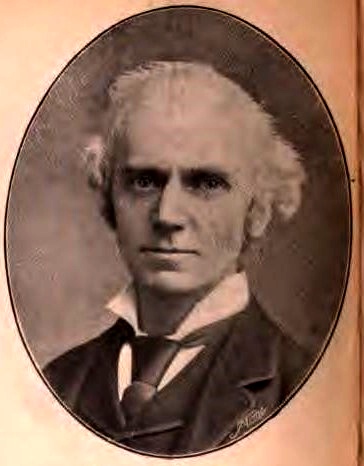
SIR
ALFRED HOPKINSON - Was and electrical engineer and Conservative
politician.
SIR ALFRED HOPKINSON
Sir Alfred Hopkinson (28 June 1851 – 11 November 1939) was an English lawyer, academic and politician who served as a Member of Parliament (MP) for two three-year periods, separated by nearly thirty years.
He was the son of John Hopkinson, a mechanical engineer, and among his brothers were John Hopkinson, a physicist and electrical engineer, and Edward Hopkinson, an electrical engineer and MP. He first stood for election to the House of Commons at the 1885 general election, when he was the unsuccessful Liberal Party candidate in Manchester East. He was unsuccessful again as a Liberal Unionist candidate at the 1892 general election, when he stood in Manchester South-West.
Hopkinson finally won a seat at the 1895 general election, when he was elected as MP for Cricklade in Wiltshire.[4] He resigned from
Parliament in February 1898, by the procedural device of accepting appointment as Steward of the Chiltern Hundreds.
Hopkinson was Vice-Chancellor of the Victoria University from 1901 to 15 July 1903 and then of the Victoria University of Manchester until 1913. In December 1914 he was appointed to the Committee on Alleged German Outrages, which in May 1915 reported on German war crimes against civilians during the invasion of Belgium in the opening months of World War I.
He received the honorary Doctor of Laws (LL.D) from the University of Glasgow in June 1901.
He returned to Parliament in March 1926, when he won a by-election for the Combined English
Universities as a
Conservative. He did not contest the 1929 general election.
A sculpture of him by John Cassidy was exhibited at Manchester in 1912. His son Austin Hopkinson also became a Member of Parliament. One of his daughters married Sir Gerald Hurst M.P.
EDWARD HOPKINSON
Edward Hopkinson (28 May 1859 – 15 January 1922) was a British electrical engineer and Conservative politician.
He was the fourth son of John Hopkinson, an engineer who was mayor of Manchester in 1882/83. Hopkinson was educated at Owen's College, Manchester and Emmanuel College, Cambridge. He graduated from Emmanuel in 1881 and was made a fellow of the college in 1883. In 1882 he began to study mechanical and electrical engineering under Sir William Siemens, and received a doctorate from the University of London.
Hopkinson was involved in a number of large pioneering electrification projects. These included the Bessbrook and Newry Tramway, the Snaefell Mountain Railway the Blackpool and Fleetwood tramways and the City and South London Railway. For a paper on his pioneering work on the Bessbrook and Newry tramway he was awarded the Telford Medal in 1888 by the Institution of Civil Engineers and for a paper on his work on the C&SLR the George Stephenson Medal in 1893 by the same society.
In 1884 he joined Mather and Platt engineering company of Salford as head of the electrical engineering department, and rose to become vice-chairman of the company.
In 1918 he was chosen as the Coalition Conservative candidate for the newly formed Clayton constituency of Manchester. He was elected, defeating the Labour MP, J E Sutton.
He married Minnie Campbell of County Antrim, and they had two children. His elder brothers included the noted physicist and engineer John Hopkinson, and Sir Alfred Hopkinson, vice-chancellor of the University of Manchester, and amongst his nephews were engineer and scientist Bertram Hopkinson, and Austin Hopkinson, MP. Edward Hopkinson died at his residence in Alderley Edge, Cheshire in 1922, aged 62.

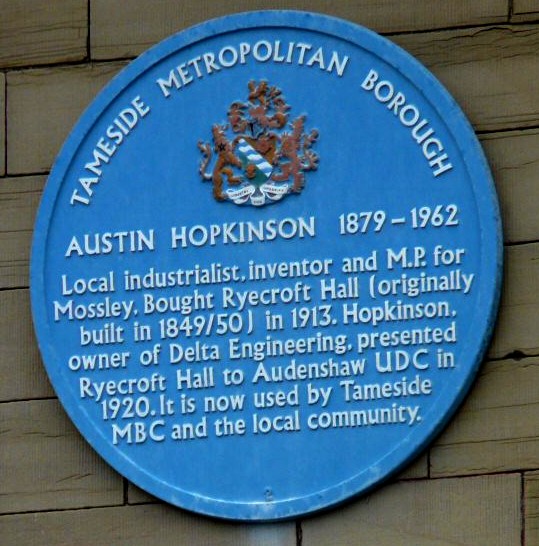
RYECROFT
HALL - Ryecroft Hall is a Grade II listed building in Audenshaw, Tameside, Greater Manchester. Originally a home to several prominent local residents, the hall was ultimately donated to the people of Audenshaw by Austin Hopkinson in 1922 and still serves the local community to the present day.
Ryecroft Hall, Manchester Road, Manchester, M34 5ZJ. Coordinates 53.4770°N 2.1303°W
AUSTIN
HOPKINSON MP
Austin Hopkinson JP (24 June 1879 – 2 September 1962) was a British industrialist and Member of Parliament
(MP) for constituencies in present-day Greater Manchester who was notable for rejecting membership of political parties and sitting as an Independent member. He represented Mossley from 1918 to 1929 and 1931 to 1945. He was also a noted benefactor to local causes, and a strong believer in noblesse oblige.
Alfred Augustine Hopkinson was born in Manchester on 24 June 1879 the son of Sir Alfred Hopkinson KC who was Vice-Chancellor of the University of Manchester from 1900 to 1913 and also served as Member of Parliament for Cricklade in the 1890s and for Combined English Universities in the 1920s. Although sharing the academic approach of his father, he applied his experience more directly to the problems of industry rather than taking up posts in the universities. He became a Justice of the Peace for Lancashire.
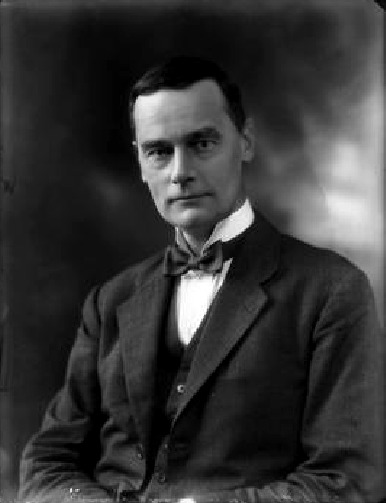
AUSTIN
HOPKINSON MP - Photo portrait of Austin Hopkinson, a member of
parliament for Greater Manchester.
In 1900 Hopkinson enlisted in the Imperial Yeomanry and served in the Second Boer War as a Lieutenant. On his return he founded a company, Pikrose (which bore the Audenshaw coat of arms as its company logo) at the Delta Works in Audenshaw. In 1908 he
invented a revolutionary
coal-cutting machine which his company made: he built a reputation as a very humane employer, and while the company was highly profitable he was uninterested in the trappings of wealth and lived frugally.
Hopkinson was elected as a councillor on Audenshaw Council from 1917 to 1934 and led the council from 1923–24 and 1928-29. Long before it became fashionable, Hopkinson converted a derelict barn to a bungalow for his own home; he donated his former home of Ryecroft Hall (which he had bought in February 1913) to the people of Audenshaw and sixteen semi-detached houses on its land to Audenshaw Council (the Hall became a community centre as well as Audenshaw council's headquarters, and the houses were used for the housing of the working class). During the First World War he again enlisted and served in the Royal Dragoon Guards as a Second Lieutenant; in the later stages of the war he re-enlisted as a Trooper (the equivalent of Private) in the same unit.
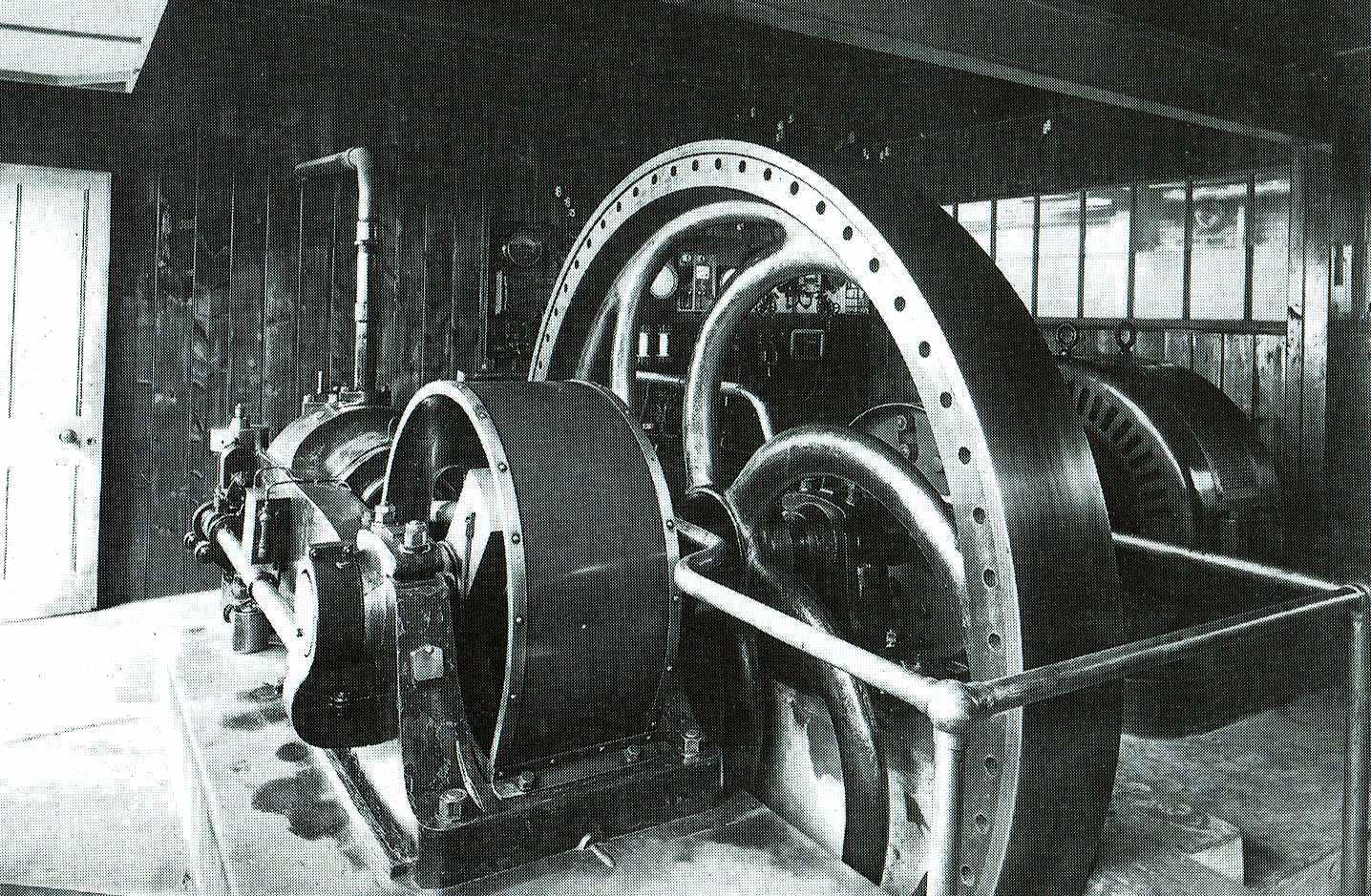
GAS
ENGINE - Mounted on substantial concrete bases and secured by large
steel bolts, this is a picture of a generator that did the rounds in
Sussex, finally ending up powering a tram in Eastbourne in the 1960s,
but not before being used to drive machinery for the Eastbourne Aviation
Company between 1911 and 1924. This generator set is virtually identical
to the one that was situated in Herstmonceux Museum around 1909,
identified by the concrete base footprint. The pine match-boarding and
electrical controls are also near identical in layout. This was because
the electrical engineer who carried out the work was the same man:
Charles William de Roemer.
For Charles, this generating room must have felt just
like the one he'd installed where he lived at Lime
Park, just on the
outskirts of Herstmonceux village. The flywheel of the engine looks like
a Crossley design but we are reliably informed that it is a National
engine. We think though that the first dynamo on this site was an Edison-Hopkinson
machine that may have been belt driven, after John Hopkinson and Thomas
Edison. That said, the generator attached to the engine seen above
is a Crompton dc machine of 110/220 votls. Charles de Roemer and/or the Baron Karl von Roemer, is
known to have had an association with John Hopkinson and possibly his
brother Charles Hopkinson. There are two large concrete bases at
Herstmonceux Museum with flywheel troughs, meaning that there must have
been two generating sets. The two bases are quite different in
configuration and in different parts of the building complex.
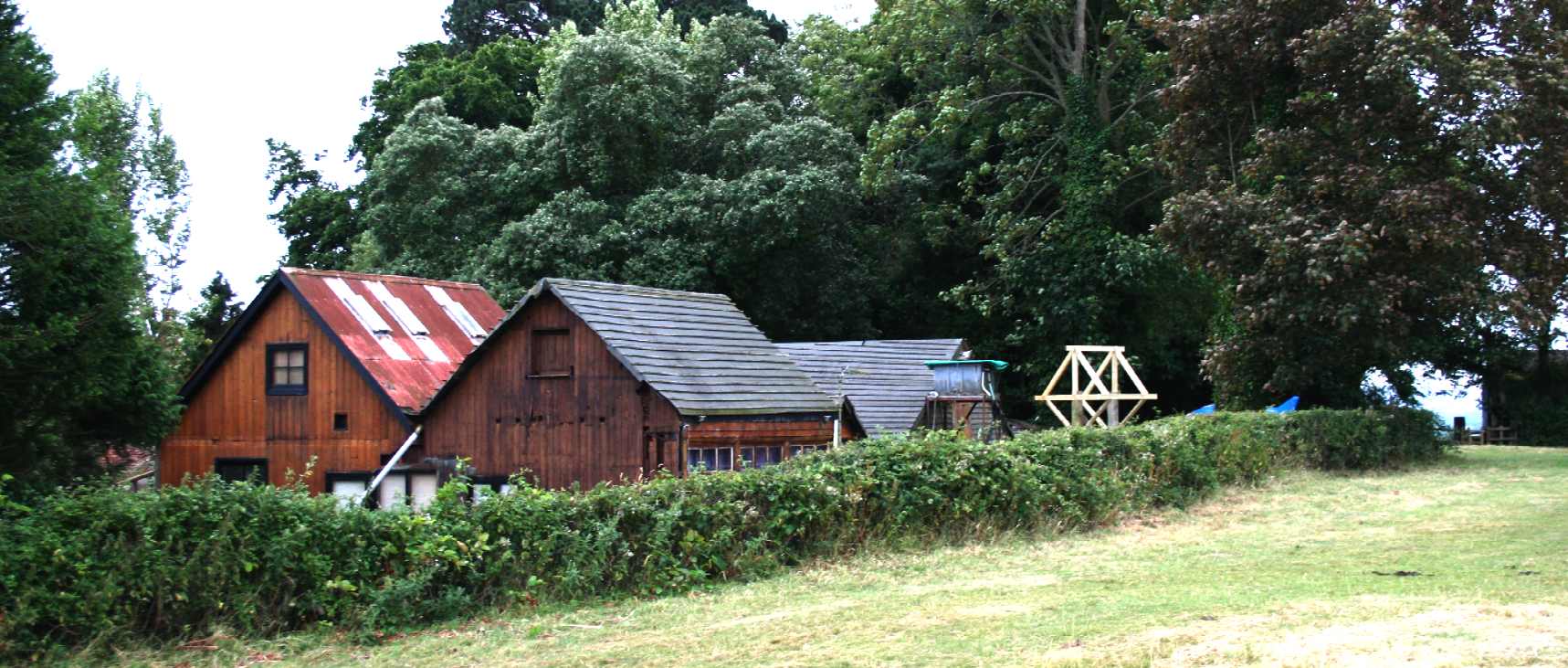
COAL
BANK - You cannot see the coal bunkers in this picture because they
are built into the bank. One range of the extant buildings was removed
in 1936 to allow the transport of the largest gas engine. It was the
intention of Charles
de Roemer to put the unit back but then fate intervened and the
Weald Supply Company came along to spike his guns. Just as Charles was
about to repair the section to the rear, along came World War
Two, when
he temporarily clad the remaining units in corrugated iron to make a hospital
for wounded airmen.
Lime Park Heritage Trust are looking at ways getting the archaeology
more intact so that visitors to the site can see what it looked like in 1909
- or get a better impression of the full size of the installation.
HERITAGE
INDEX A - Z
AIR
RAID SHELTER
AVIATION
- EASTBOURNE
BARCLAYS
BANKING LET DOWN - MISSING ACCOUNT MONEY
BARON
CARL VON ROEMER & CHARLES de ROEMER
CAMPBELL
HALL - BLUEBIRD ELECTRIC CARS
COAL
BUNKER
GAS
ENGINES - COAL CONVERSION, INTERNAL COMBUSTION
HX
FIRE STATION
HX
MUSEUM
HX
SCIENCE EXHIBITS
OBSERVATORY
- HERSTMONCEUX CASTLE
SX
MUSEUMS
PLANNING
APP JAN 2015
RAF
BEACHY HEAD
RAF
HERSTMONCEUX
RAF
HERSTMONCEUX & WARTLING
RAF
SEAFORD BAY
SOLAR
LADY - STATUE
SUMMER
SOLSTICE
SUSSEX
TRUGGERY
THOMAS
ALVA EDISON
TOURISM
DCMS
TREE
HOUSES -
TREE
PRESERVATION
TRUGS
WORLD
ELECTRIFICATION HISTORY
WWII
BOMB PROOF SHELTER
LINKS
& REFERENCE
https://en.wikipedia.org/wiki/John_Hopkinson
https://en.wikipedia.org/wiki/Edward_Hopkinson
https://en.wikipedia.org/wiki/Austin_Hopkinson
https://en.wikipedia.org/wiki/Alfred_Hopkinson
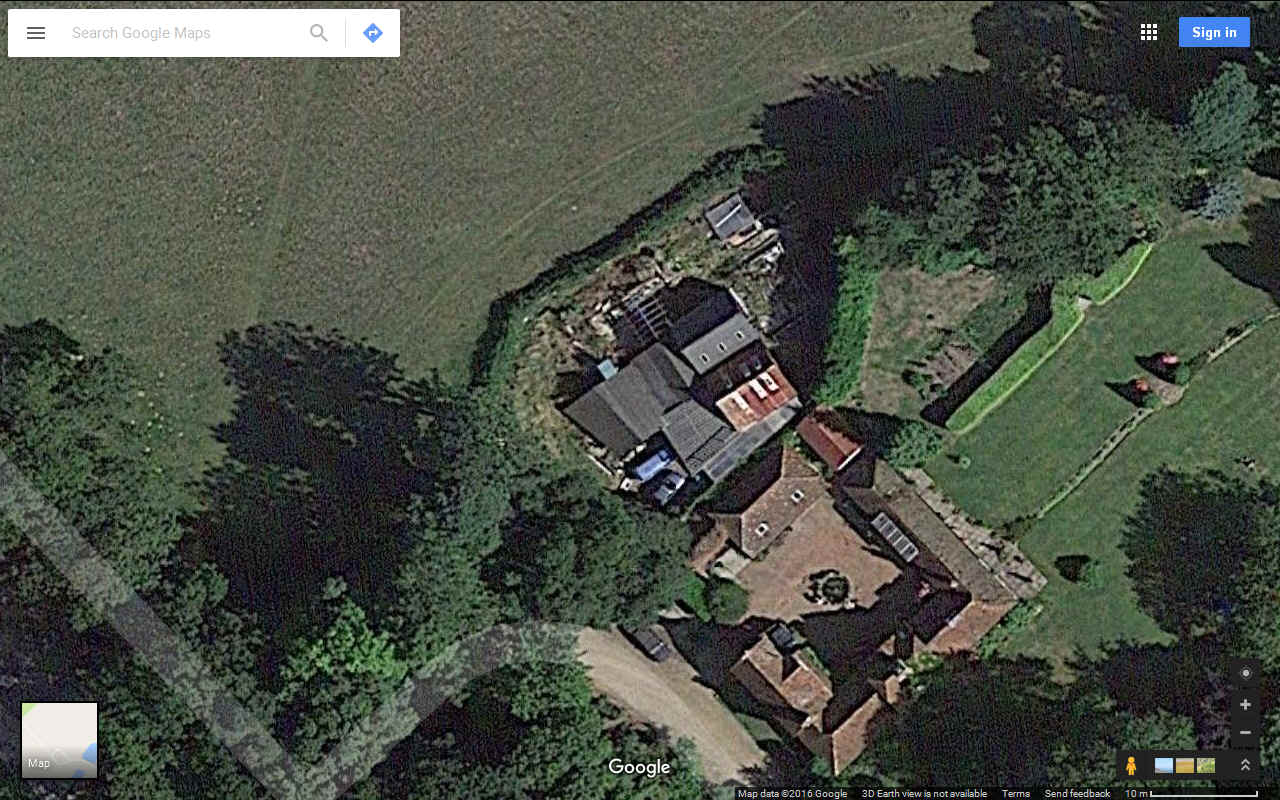
GOOGLE
MAPS
- The detail is not that great and the situation on the land is
significantly changed in that the site has undergone a massive clean up.
You cannot see the coal bunkers in this picture, but they are to the
rear of the main buildings.
|








